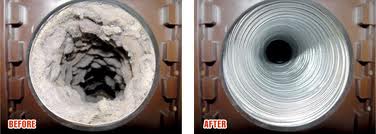Dryer and Vent Cleaning Yorktown, VA
There’s a hidden fire hazard in almost every home…it’s the dryer vent!

Reduce the Risk of a Dryer Fire
Over time, your dryer vent fills with lint that sneaks by your dryer’s filter. Fires can occur when lint builds up in the dryer or in the exhaust duct. Lint can block the flow of air, cause excessive heat build-up, and result in a fire in some dryers. Isolated incident? Not at all. The Consumer Product Safety Commission estimates that over 15,000 dryer related fires occur each year causing an estimated 97 million dollars in property loss.
Some facts and figures…
- Clothes dryers can be found in 81.5 million homes throughout the United States.
- A full load of wet clothes contains about one half gallon of water. As water is removed lint becomes detached from the clothes and is carried out through the exhaust vent.
- Clothes dryers are one of the most expensive appliances in your home to operate. The longer it runs the more money it costs you.
- Lack of maintenance is the leading cause of dryer fires. Clothes dryers must vent hot air to the outside of the house. If lint builds up in the exhaust vent or inside and around the dryer, it can block the flow of air causing the dryer to perform poorly, raising the operating temperature of the dryer and causing overheating. Placing combustible or improper materials in the dryer, such as clothes that are soiled with volatile chemicals or items like foam-backed rugs and athletic shoes.
- Insufficient airflow resulting from improper installation or crushed exhaust vent.
- Using plastic or vinyl venting materials.
Here’s what you can do to help prevent dryer fires…
- Clean the lint screen/filter before or after drying each load of clothes. If clothing is still damp at the end of a typical drying cycle or drying requires longer times than normal this may be a sign that the screen or the exhaust duct is blocked.
- Clean the dryer vent and exhaust duct periodically. Check the outside dryer vent while the dryer is operating to make sure exhaust air is escaping. If it is not, the vent or the exhaust duct may be blocked. To remove a blockage in the exhaust path,it may be necessary to disconnect the exhaust duct from the dryer. Remember to reconnect the ducting to the dryer and outside vent before using the dryer again.
- Clean behind the dryer, where lint can buildup. Have aqualified service person clean the interior of the dryer chasis periodically to minimize the amount of lint accumulation. Keep the area around the dryer clean and free of clutter.
- Take special care when drying clothes that have been soiled with volatile chemicals; such as gasoline, cooking oils, cleaning agents, or finishing oils and stains. If possible wash the clothing more than once to minimize the amount of volatile chemicals on the clothes and preferably hang the clothes to dry. If using a dryer, use the lowest heat setting and a drying cycle that has a cool down period at the end of the cycle. To prevent clothes from igniting after drying, do not leave the dried clothes in the dryer or piled in a laundry basket.
- Replace plastic or foil, accordion-type ducting material with a rigid or corrugated semi-rigid metal duct. Most manufacturers specify the use of arigid or corrugated semi-rigid metal duct, which provides maximum airflow. The flexible plastic or foil type duct can more easily trap lint and is more susceptible to kinks or crushing, which can greatly reduce the airflow. Turn the dryer off when leaving the home. Do not leave the dryer running if you go out because if it malfunctions no one will be there to avert possible disaster. Make sure that the dryer is plugged into an outlet suitable for its electrical needs. Overloaded electrical outlets can result in blown fuses or tripped circuit breakers. Dryer should be installed by a professional.
- Gas-powered dryers should be inspected by a professional occasionally to ensure that the gas line and connection are intact and free of leaks.

